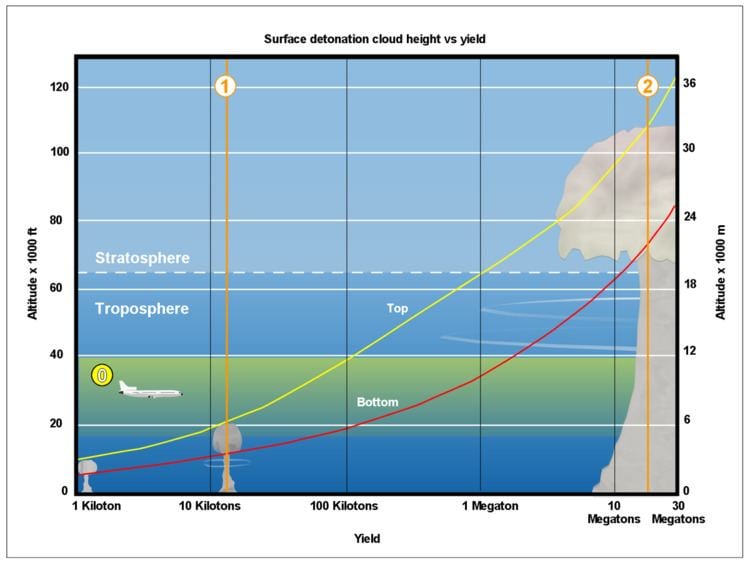 | ||
TNT equivalent is a convention for expressing energy, typically used to describe the energy released in an explosion. The "ton of TNT" is a unit of energy defined by that convention to be 4.184 gigajoules, which is the approximate energy released in the detonation of a metric ton (1,000 kilograms or one megagram) of TNT. The convention intends to compare the destructiveness of an event with that of conventional explosives, of which TNT is a typical example (although other conventional explosives such as dynamite contain more energy).
Contents
Kiloton and megaton
The "kiloton (of TNT)" is a unit of energy equal to 4.184 terajoules.
The "megaton (of TNT)" is a unit of energy equal to 4.184 petajoules.
The kiloton and megaton of TNT have traditionally been used to describe the energy output, and hence the destructive power, of a nuclear weapon. The TNT equivalent appears in various nuclear weapon control treaties, and has been used to characterize the energy released in such other highly destructive events as an asteroid impact.
Historical derivation of the value
A gram of TNT releases 2673–6702 J (joules) upon explosion. The energy liberated by one gram of TNT was arbitrarily defined as a matter of convention to be 4184 J, which is exactly one kilocalorie.
An explosive's energy is normally expressed as the thermodynamic work produced by its detonation, which for TNT has been accurately measured as 4686 J/g from a large sample of air blast experiments, and theoretically calculated to be 4853 J/g.
The measured, pure heat output of a gram of TNT is only 2724 J, but this is not the important value for explosive blast effect calculations.
Alternative TNT equivalency can be calculated as a function of when in the detonation the value is measured and which property is being compared.
A kiloton of TNT can be visualized as a cube of TNT 8.46 metres (27.8 ft) on a side.
Conversion to other units
1 ton TNT equivalent is approximately:
Relative effectiveness factor
The relative effectiveness factor (RE factor), relates an explosive's demolition power to that of TNT, in units of the TNT equivalent/kg (TNTe/kg). The RE factor is the relative mass of TNT to which an explosive is equivalent: the greater the RE, the more powerful the explosive.
This enables engineers to determine the proper masses of different explosives when applying blasting formulas developed specifically for TNT. For example, if a timber-cutting formula calls for a charge of 1 kg of TNT, then based on octanitrocubane's RE factor of 2.38, it would take only 1.0/2.38 (or 0.42) kg of it to do the same job. Using PETN, engineers would need 1.0/1.66 (or 0.60) kg to obtain the same effects as 1 kg of TNT. With ANFO or ammonium nitrate, they would require 1.0/0.74 (or 1.35) kg or 1.0/0.42 (or 2.38) kg, respectively.
RE factor examples
*: TBX (thermobaric explosives) or EBX (enhanced blast explosives), in a small, confined space, may have over twice the power of destruction. The total power of aluminized mixtures strictly depends on the condition of explosions.
